St. Patrick's Day Mar 17 Today we started with breakfast at the hotel before heading off to Newgrange. We didn't have the full Irish breakfast (maybe tomorrow) because it's Friday (during Lent, i.e., no meat). Instead, we had scrambled eggs and smoked salmon. 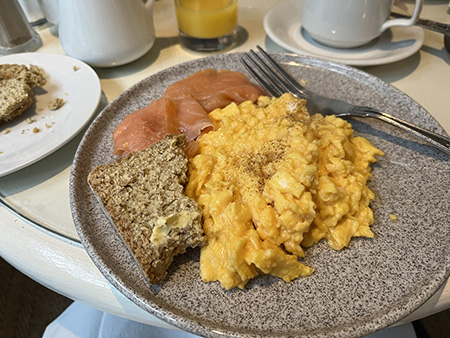
Scrambled eggs, smoked salmon and brown bread At Newgrange we joined a group of others who signed up for a tour of Knowth and Newgrange, the two largest passage tombs in Ireland. Archeologists estimate that they were created in the late Neolithic age, perhaps as late as 3200 BC, so about 5,000 years ago. Each one is comprised of an artificial mound and a passage within it (Knowth has two passages). Around the perimeter of the mounds were large kerbstones, sometimes decorated with mysterious petroglyphs. The entrances of the two passages at Knowth are aligned with the rising and setting of the sun at the equinox, and the passage into the center of Newgrange is aligned with the rising sun on the winter solstice. The remarkable things about the sites are the incredible amount of work needed to create them and that the original stones with hand-carved works of art remain on the sites. 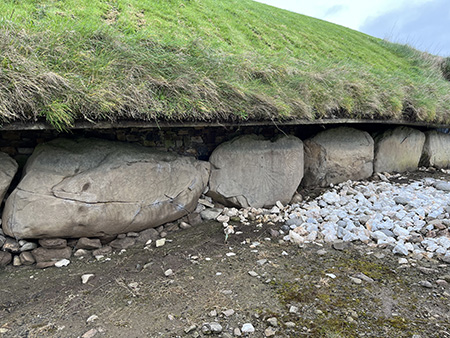
The mound at Knowth 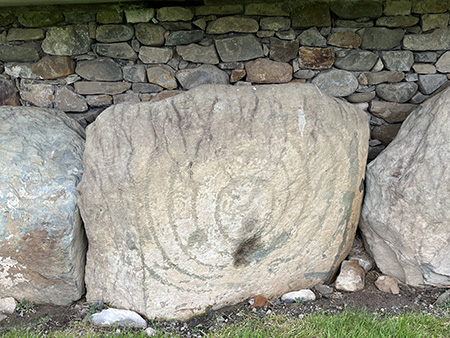
Kerbstone at Knowth with mysterious markings 
One of the smaller mounds at Knowth 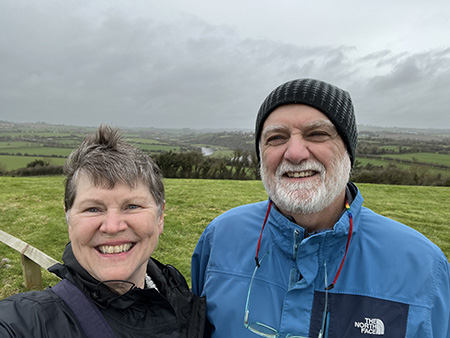
At Knowth, Boyne River valley behind us Visitors are allowed to go inside the passage at Newgrange, but not at Knowth because the passage is not stable enough. On the other hand, visitors are permitted to climb steps to the top of Knowth and walk around its surface, getting a grand view of Boyne River valley. The mounds are presently covered in thick green grass, and Steve asked if the Office of Public Works (the government agency which manages the site) mows them. We learned that the larger mounds are mown by a robotic mower and the smaller ones by a person using the push-mower-and-rope method. At Newgrange, the central chamber at the end of the passage is capped with a corbeled roof which has remained undisturbed and watertight for five millennia. Standing inside the chamber, we talked with the guide about the unanswered questions of just how Neolithic builders could have accomplished this, and Steve suggested perhaps it was the work of aliens. 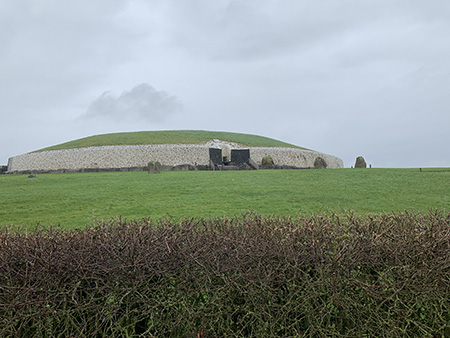
Newgrange 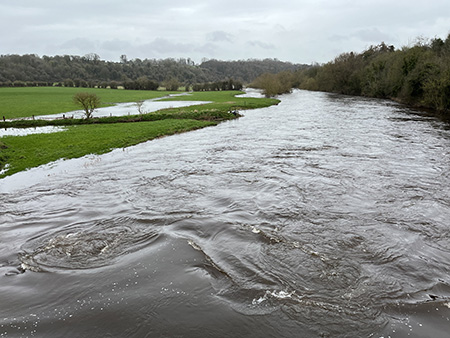
River Boyne 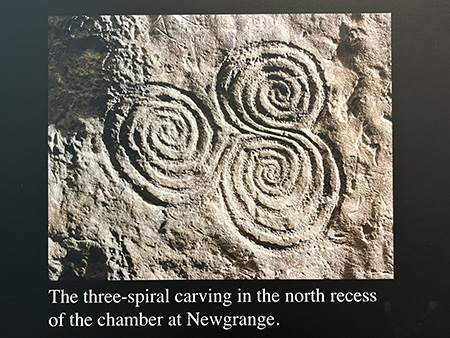
The triple spiral resembled the eddies in the River Boyne We had hoped to perhaps leave Newgrange in time to start our tour at the Slane distillery at noon, though the tickets we had purchased were for the 2 pm tour. But it was 12:30 before we left Newgrange, so that plan was off the table. Instead, we opted to go to the Slane estate a little early and have a latte while we waited for our tour. 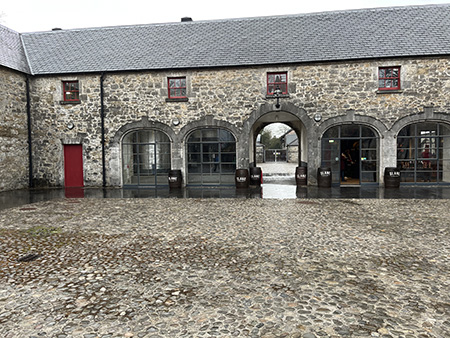
Stables/Distillery at Slane Castle The distillery is located on the grounds of Slane Castle, a place still inhabited by the Conyngham family, an aristocratic family whose claim to the estate originates in the 18th century. Our guide made it sound like the first Conyngham arrived in Slane after serving with the Williamite forces in the Battle of Boyne because "he liked the area so returned to buy land," when a more accurate version is that the lands were confiscated from the Fleming family after the defeat of the Jacobite forces in the battle. The 1st Earl Conyngham may have purchased the lands, but only after the previous owner was forced to relinquish them. In any case, the Conynghams are still around, and Alex, son of the 8th Marquess Conyngham lives in the castle. In the 1980's, seeking a revenue source to maintain the aging castle, the Conyngham family hosted a rock concert on the castle grounds with Thin Lizzy for the headline performance and a then-unknown group, U2, serving as the opening act. The concert was an immediate success and has been a mostly annual tradition since, featuring a cavalcade of rock stars, i.e., Rolling Stones, Bob Dylan, Bruce Springsteen, David Bowie, Madonna, and others. The events draw a massive crowd (85,000 or more) to the tiny town of Slane, which closes all roads in a 5-km radius during the day of the concert. Attendees arrive by car, bus, bicycle, etc., walking the last 30-minutes from outlying parking areas to reach the concert venue on the castle grounds. Needless to say, the plan to raise revenue to save the castle has been a success. The concert returns this year after a couple years' hiatus during the pandemic. The performer is Harry Styles, a British musician whose Slane Concert sold out in 17 minutes. A group by the name of Inhaler will open for them - a band which includes the son of U2's Bono. 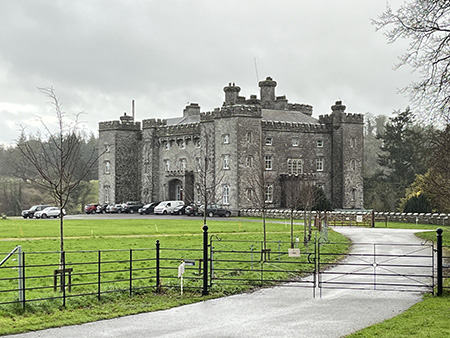
Slane Castle The establishment of a distillery on the grounds is a relatively recent enterprise of Alex Conyngham, Earl of Mount Charles, who partnered with the American company Brown-Forman to create a brand of affordable blended whiskey, Slane Irish whiskey. Run-down buildings on the castle grounds (the stables and associated buildings of the castle mews) were renovated to house the distilling operations. This operation is what we came to view (and the product to taste.) 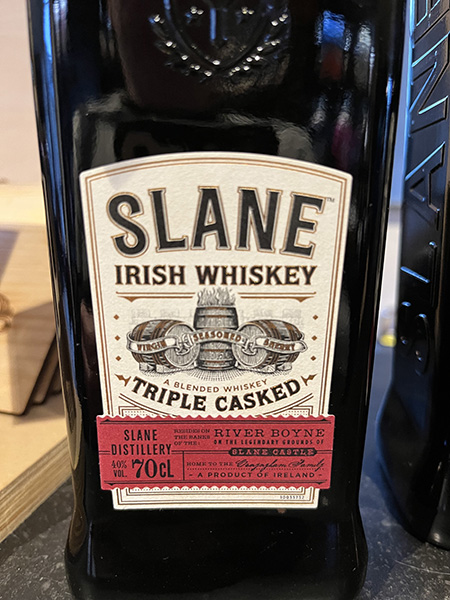
Slane Irish Whiskey The tour lasted longer than the advertised hour, but it was an interesting presentation to a small group of about 12 of us. We walked through the old stables, now housing huge vessels for making and distilling whiskey. The final product of the distilling process is aged in three types of wooden casks - American virgin oak barrels (oak barrels "toasted" with fire but unused for any previous purpose), whiskey barrels previously used for aging American whiskey (specifically Jack Daniels), and sherry casks. The usual bottle of Slane whiskey is a blended combination of liquid matured in these casks. The goal of Alex Conyngham was to create an affordable and respected Irish whiskey, and Slane whiskey is growing in popularity in the U.S. as well as other parts of the world. 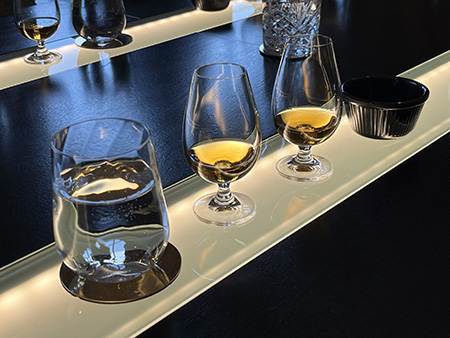
Tasting samples The distillery operations required the addition of a couple of buildings on the grounds, partly because regulations limit changes which can be done to historical structures and the planners wanted to incorporate some industrial processes in buildings which didn't spoil the looks of the grounds. The ideal placement of one of the added buildings was extremely close to a fairy fort on the castle grounds. A fairy fort is a circular patch made by the vanished remnants of a hut or stone ring from centuries ago, but it is associated with the superstitious belief that these spots are defended by spirits who can bring great harm to those who disturb them. For many Irishmen, disrupting or even going near a fairy fort is ill-advised, with lots of tales about the folly and even death of those who ignored the risk. So the distillery was reluctant to put the new building where they really wanted it until someone suggested asking the fairies if they could considering moving to a different spot. According to our tour guide, that's how they handled it. Alex Conyngham, Earl of Mount Charles, joined a handful of CEO's associated with this business venture, and they stood at the fairy fort and presented their request. The fairies apparently were gracious about the whole thing and the new building was placed near the "abandoned" fairy fort. Or it could be that the fairies were getting compensated with some of the local product since our guide said that they refer to the portion of whiskey lost to evaporation as the "fairy's share" vs. "angel's share," the term used by other distillers. 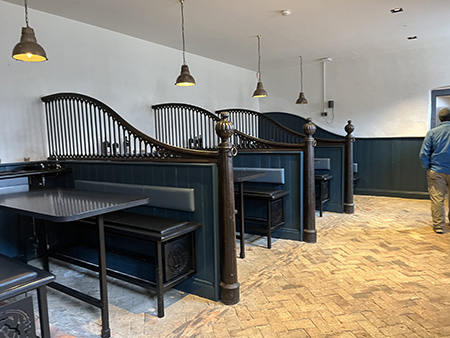
Horse stalls converted to cafe stalls By the time we left Slane Castle, it was too late to see the St. Patrick's Day parade through the village, but we were later informed by a local that we "hadn't missed much - a lot of tractors." The afternoon sun promised by the weather forecast never actually materialized, and with a light sprinkle continuing off and on throughout most of the day, I think even several of the local spectators probably enjoyed the parade through the windows of a local restaurant, pub or shop (though few of the shops were opened today since St. Patrick's Day is a national bank holiday). Instead of parking near Main Street as we had planned, we continued our drive through town and went to the top of the Hill of Slane. We encountered a stream of cars heading back down the hill and thought we had chosen poorly in thinking we could find a parking spot at the top, but it turned out that we were arriving just as the St. Patrick's Day Vespers procession was leaving the cemetery and heading off the grounds. We parked and got out just in time to see the end of that happening, and we watched a long line of people trudge down the hill and toward their cars. 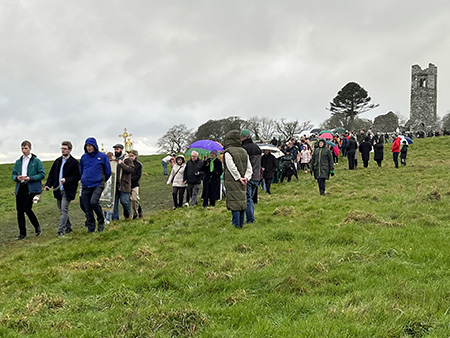
Procession leaving the Hill of Slane After that, we pretty much had the Hill of Slane to ourselves, with a few others popping in to walk around. We tried to see the Hill of Tara in the distance on the horizon to the south, but with the low clouds and dimming light, we weren't confident that we were looking in the place. 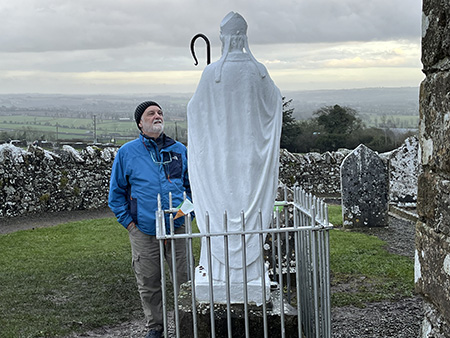
Steve gazes at the statue of St. Patrick on the Hill of Slane We paused and talked with a few people still mingling there, but by far the most interesting conversation was had with a jovial red-bearded man named Tom. We learned that he is an artisanal blacksmith who lives near Slane, but it was his general enthusiasm for the stories of Irish lore that we most enjoyed. He was eager to tell us the story of St. Patrick's Easter fire, and he was so colorful in his account that Steve asked him, "Do I need to pay you for this guided tour?" He took that with the good humor we intended, and we stood and chatted with him for nearly an hour. He showed us the copse at the top of the hill, outside the grounds of the monastery ruins on the Hill of Slane, the spot where St. Patrick ignited the fire that aroused the High King of Ireland, who demanded an explanation. Seeing this tip of the hill required hoisting ourselves onto a stone to see over the stone wall enclosure. As I clung to the top of the rock wall and Steve braced me from the back, Tom narrated the tale of the Easter bonfire which ultimately led the High King to grant permission to Patrick to spread word of the Christian tenets of faith. He also showed us the grave of Erc of Slane, a pagan Druid who was converted to Christianity by St. Patrick and was appointed the first Bishop of Slane. He died in 514 near Slane, and his remains are said to rest under a triangular stone in the graveyard on the Hill of Slane. 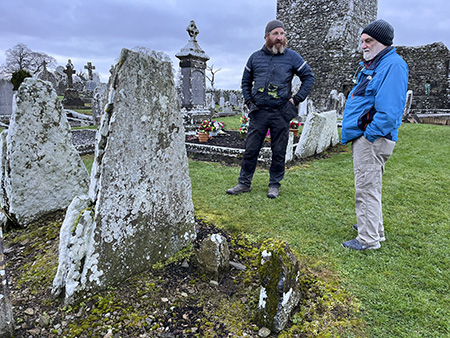
Tom shows us the resting place of Erc of Slane 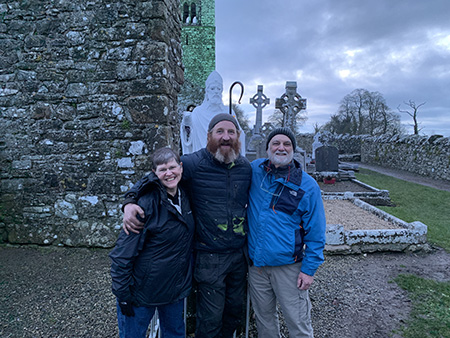
Our new friend It was past sundown when we left, but not before getting more information about him and his art as well as a photo of ourselves with him. (See https://mythicalireland.com/collections/tom-king-an-gobha-creations) With darkness settling around Slane, we drove back to the hotel, went to dinner in their restaurant and made our way back to our room for a good night's sleep. 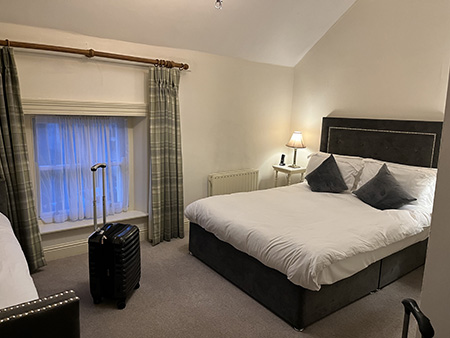
Our room in the Conyngham Arms Hotel Tomorrow we depart Slane and head for Donegal. Next: On to Donegal |
| Other stuff |
|
back to the top |